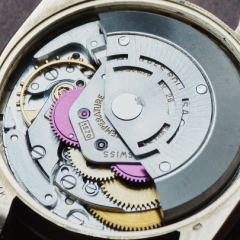-
Recently Browsing
- No registered users viewing this page.
-
Topics
-
Posts
-
Just a quick update on my T17. I just finished the service and, boy, was this nerve-wrecking.... I bent the hairspring a few times. Stupid accidents. Once it was beyond repair and I had to get a donor movement. The replacement hairspring turned out to be a few millimeters shorter and therefore the watch was running 6min too fast even when the regulator was set to the slowest position. So I needed to get timing washers (see another post here: https://www.watchrepairtalk.com/topic/25505-30t2-adjustment-of-timing-washers/?do=findComment&comment=248100). After all, I'm now, getting a 310° amplitude (fully wound, dial up, lift angle 54°). About 250 in vertical positions. Quite a drop, but apparently not too abnormal for a 90-year-old watch with a slow beat rate (18000bph) and rather heavy balance wheel. After 24h I still get 280 (horizontal) and 220 (vertical). And now the highlight: 66h of power reserve! You may remember that I posted that I used a slightly weaker, but also slightly longer mainspring than prescribed. See my comments above. I used GR 3937 (instead of GR 3632). So I recommend this mainspring and ticker oils (9020 on escape wheel and HP1300 on the rest of the train).
-
OK! I was able to get a nice set of timing washers from ebay! And they worked really well. I needed to slow down the movement by about 6min and I put four (=two pairs) of 3-minute washers (rated for the the size of the movement) and it did pretty much exactly that. On one pair of screws, there were already washers. So I added a second washer on those screws. Maybe not ideal, but it doesn't cause any problems. Poise is ok.. not perfect.. but I had so many issues with the watch that I decided to accept it. It's a 90-year-old watch. Delta is around 40 seconds.
-
By RichardHarris123 · Posted
I think it is friction fit, there are tools to remove them, cheaper versions are available. You could try adapting some pliers, see my crap drawing. The pushers are available in various sizes, you could measure once the tube is removed. -
The entry jewel's not as bad but seems still too much lock. I do epilame the escape wheel and pallet jewels, then run dry for about 15 minutes, then put 9415 in exit jewel very little at a time and check with backlight how the oil's distributed. Another question is about capped escape wheels. Should I somehow wear the epilame off the pivots before installing the wheel? I normally let the escape wheel run dry for that said 15 minutes when there's no cap jewel.







.thumb.jpg.cb17a66989f1e796fd4217db2e9ca9df.jpg)


Recommended Posts
Join the conversation
You can post now and register later. If you have an account, sign in now to post with your account.
Note: Your post will require moderator approval before it will be visible.